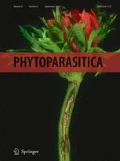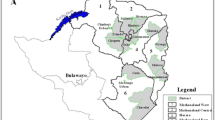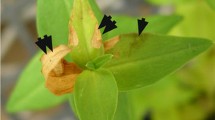Abstract
A survey was conducted in order to record the ornamental plants that are hosts of tomato spotted wilt virus (TSWV) and impatiens necrotic spot virus (INSV) in Greece. Polyclonal antibodies prepared against the N protein of a Greek isolate of TSWV fromGerbera jamesonii (GR-34) were used. Leaf samples were taken from plants showing typical symptoms of tospovirus infection such as chlorotic and necrotic rings on the leaves and malformation and necrosis of the flowers. The samples were tested by double antibody sandwich enzyme-linked immunosorbent assay (DAS-ELISA) using polyclonal antibodies to the N proteins of TSWV and INSV (NL-07). ELIS A-positive samples were mechanically transmitted to plants ofPetunia hybrida, Nicotiana rustica andN. benthamiana to confirm infection. Although none of the samples was found infected with INSV, TSWV presence was recorded in 42 botanical species that belong to 40 genera in 27 families. Among them the speciesBeloperone guttata, Coleus barbatus, Impatiens petersiana andLilium auratum are reported for the first time as hosts of TSWV, whereasBegonia sp.,Catharanthus roseus Celosia cristata, Dianthus chinensis, Fuchsia hybrida andStephanotis floribunda are found as new hosts of the virus in Greece. Thrips collected from TSWV-infected plants were in most cases identified asFrankliniella occidentalis, except from plants ofDendranthema sp. andDianthus caryophyllus whereThrips tabaci individuals were also identified. Different percentages of transmitters were noticed when the thrips populations collected from TSWV-infected ornamental hosts were tested for transmission of TSWV.
Similar content being viewed by others
References
Avrameas, S. (1969) Coupling of enzymes to proteins with glutaraldehyde.Immunochemistry 6:43–52.
Chatzivassiliou, E.K., Katis, N.I. and Peters, D. (1998) Transmission of tomato spotted wilt virus (TSWV) byThrips tabaci grown on tobacco or non tobacco crops.Proc. 4th Int. Symp. on Tospovirus and Thrips in Floral and Vegetable Crops (Wageningen, the Netherlands), pp. 59–62.
Chatzivassiliou, E., Livieratos, J., Avgelis, A., Katis, N. and Lykouressis, D. (1996) Occurrence of tomato spotted wilt virus in vegetable and ornamental crops in Greece.Acta Hortic. 431:49–54.
Chatzivassiliou, E.K., Nagata, T., Katis, N.I. and Peters, D. (1999) The transmission of tomato spotted wilt tospovirus (TSWV) byThrips tabaci Lind. (Thysanoptera: Thripidae) populations originating from leek.Plant Pathol. 48:700–706.
Clark, M.E and Adams, A.N. (1977) Characteristics of the microplate method of enzyme linked immunosorbent assay for the detection of plant viruses.J. Gen. Virol. 34:475–483.
Corts, I., Livieratos, I.C., Dercks, A., Peters, D. and Kormelink, R. (1998) Molecular and serological characterisation of iris yellow spot virus, anew distinct tospovirus species.Phytopathology 88:1276–1282.
De Avila, A.C., De Haan, P., Kitajima, E.W., Kormelink, R., Resende, R. de O., Goldbach, R.W. and Peters, D. (1992) Characterisation of a distinct isolate of tomato spotted wilt virus (TSWV) fromImpatiens sp. in the Netherlands.J. Phytopathol. 134:133–151.
Goldbach, R.W. and Peters, D. (1994) Possible causes of the emergence of Tospovirus diseases.Sem. Virol. 5:113–120.
Jenser, G. (1982) Tripszek—Thysanoptera.in: Magyarorszag Allatvilaga [Fauna Hungariae]. Vol. 13. Akademiai Kiado, Budapest, Hungary.
Katis, N. and Avgelis, A. (1991) [Tomato spotted wilt virus: New threat for tomato and pepper crops in Northern Greece.]Abstr. 15th Scientific Meeting of the Greek Society of Horticulture (Thessaloniki, Greece), p. 69 (in Greek).
Lindorf, M.B. (1931) Further studies of the transmission of the pineapple yellow spot virus byThrips tabaci.Phytopathology 21:999.
Lindorf, M.B. (1932) Transmission of the pineapple yellow-spot virus byThrips tabaci.Phytopathology 22:301–324.
Livieratos, I.C., Lykouressis, D. and Katis, N.I. (1994) [Studies on the genusTospovirus in Northern Greece.]Abstr. 7th. Panhellenic Phytopathological Congr. (Athens, Greece), p. 41 (in Greek).
Matteoni, J.A. and Allen, W.R. (1989) Symptomatology of tomato spotted wilt virus infection in florist’s chrysanthemum.Can. J. Plant Pathol. 11:373–380.
Murphy, F.A., Fauquet, G.M., Bishop, D.H.L., Ghabrial, S.A., Jarvis, A.W., Martelli, G.P., Mayo, M.A. and Summers, M.D. (1995) Virus Taxonomy. Sixth Rep. Int. Committee on Taxonomy of Viruses.Arch. Virol. Suppl. 10:1–586.
Palmer, J.M., Mound, L.A. and Heaume, G.J. (1992)in: Betts, C.R. [Ed.] HIE Guides to Insects of Importance to Man: Thysanoptera. CAB International, Wallingford, UK.
Peters, D. (1998) An updated list of plant species susceptible to tospoviruses. pp. 107–110.in: Peters, D. and Goldbach, R.W. [Eds.] Recent Progress in Tospovirus and Thrips Research. Wageningen Agricultural University, Wageningen, the Netherlands.
Priesner, H. (1964) Ordnung Thysanoptera. Akademie-Verlag, Berlin, Germany.
Sakimura, K. (1962) The present status of thrips-borne viruses. pp. 33–40.in: Maramorosch, K. [Ed.] Biological Transmission of Disease Agents. Academic Press, New York, NY.
Selman, I.W., Brierley, G.F., Pegg, G.F. and Hill, T.A. (1961) Changes in the free amino acids and amides in tomato plants inoculated with tomato spotted wilt virus.Ann. Appl. Biol. 49:601–615.
Strassen, R. zur (1986)Frankliniella occidentalis (Pergande, 1895) ein nordamerikanischer Fransenflugler (Thysanoptera) als neuer Bewohnereuropaischer Gewachshauser. Nachrichtenbl.Dtsch. Pflanzenschutzdienst. (Stuttgart) 38(6):86–88.
Tsakiridis, J.P.and Gooding, G.V. Jr. (1972) Tomato spotted wilt virus in Greece.Phytopathol. Mediterr. 11:42–47.
Ullman, D.E., Cho, J.J., Mau, R.F.L., Hunter, W.B., Westcott, D.M. and Custer, D.M. (1992) Thrips- tomato spotted wilt virus interaction: morphological, behavioral and cellular components influencing thrips transmission.Adv. Dis. Vector Res. 9:195–240.
Vaira, A.M., Roggero, P., Luisoni, E., Masenga, V., Milne, R.G. and Lisa, V. (1993) Characterization of two tospoviruses in Italy: tomato spotted wilt and impatiens necrotic spot.Plant Pathol. 42:530–542.
Van deWetering, F., Goldbach, R. and Peters, D. (1996) Tomato spotted wilt virus ingestion by first instar larvae ofFrankliniella occidentalis is a prerequisite for transmission.Phytopathology 86:900–905.
Volvas, C. and Avgelis, A. (1994) Infezione da TSWV Tospovirus su poinodoro e peperone nell isola di Creta.Inf. Fitopatol. 1:55–56.
Wijkamp, I. and Peters, D. (1993) Determination of the median latent period of two tospoviruses inFrankliniella occidentalis, using a novel leaf disk assay.Phytopathology 82:986–991.
Yudin, L.S., Tabashnik, B.E., Cho, J.J. and Mitchell, W.C. (1988) Colonization of weeds and lettuce by thrips (Thysanoptera: Thripidae).Environ. Entomol. 17:522–526.
Author information
Authors and Affiliations
Corresponding author
Rights and permissions
About this article
Cite this article
Chatzivassiliou, E.K., Livieratos, I., Jenser, G. et al. Ornamental plants and thrips populations associated with tomato spotted wilt virus in Greece. Phytoparasitica 28, 257–264 (2000). https://doi.org/10.1007/BF02981804
Received:
Revised:
Issue Date:
DOI: https://doi.org/10.1007/BF02981804




